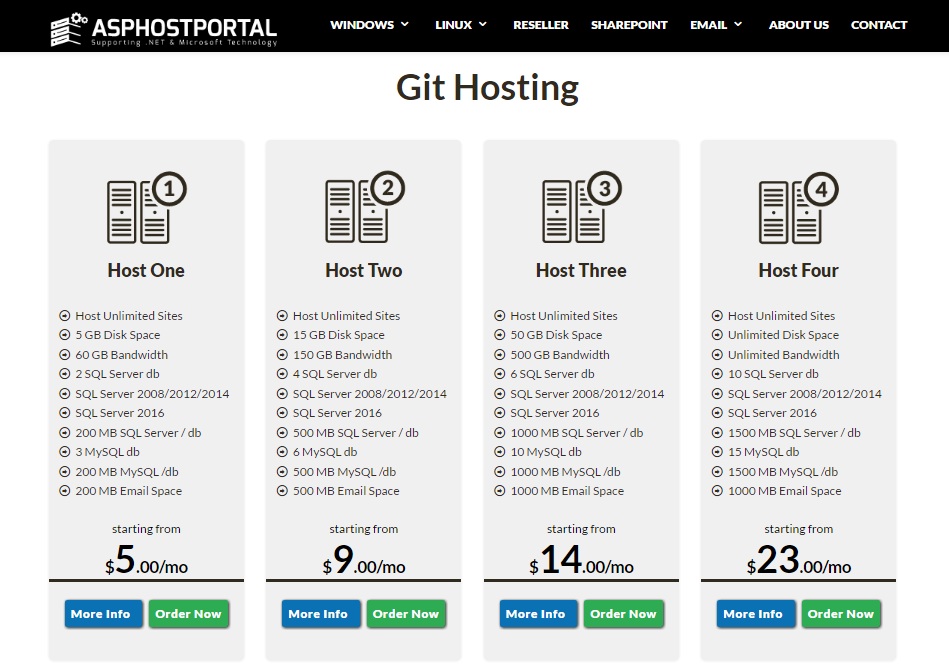Choosing a Git hosting service is a big decision. You put a lot of time and effort into your Git website and it is important that your Git site be up and running as often as possible.
There are so many different Git web hosts that it can be difficult to narrow the selection and choose the right one for your Git website.
Once you choose a company you will also have to choose a service package. Git hosts often offer a wide variety of different packages each with different service options.
[su_note note_color=”#f3f3ef” text_color=”#373737″ radius=”20″]At ASPHostPortal you don’t have a limit on the amount of technical support you can access. The company provides 24/7 round the clock assistance for those with questions, concerns, and problems.[/su_note]
Cheap and Reliable Git Hosting Provider
[su_heading align=”justify” margin=”20″]ASPHostPortal.com is Microsoft No #1 Recommended Windows and ASP.NET Spotlight Hosting Partner in United States, Click here for more information.[/su_heading]
ASPHostPortal considers reliability extremely important and with them your Git site runs smoothly and continuously just like you wanted it to in the beginning. Their prices are also amazingly affordable.
Even though a lot of Git hosting sites now provide customer services, none does it better than ASPHostPortal who place their clients above all else. They use a variety of ways just to make this service available and accessible by all who have queries and questions.
Their customer service makes posting your Git website easy and fun to do as they are always there to offer quick assistance to aid you. You can use payment methods like PayPal.
Apart from their unlimited domain account which is highly acclaimed among users, you can still get a great account that has an exhaustive list of products which are important for all persons who want to host their Git services.
Powerful ASPHostPortal’s Git Hosting
Git is a free and open source distributed version control system designed to handle everything from small to very large projects with speed and efficiency. Git is easy to learn and has a tiny footprint with lightning fast performance. It outclasses SCM tools like Subversion, CVS, Perforce, and ClearCase with features like cheap local branching, convenient staging areas, and multiple workflows.
Get the best, cheap and reliable Git hosting with them. Why wait longer?
[su_service title=”World Class Control Panel” icon=”icon: rocket” icon_color=”#3c3c3c” size=”18″]They use World Class Plesk Control Panel that support one-click installation.[/su_service]
[su_service title=”Uptime & Support Guarantees” icon=”icon: rocket” icon_color=”#3c3c3c” size=”18″]They are so confident in their hosting services they will not only provide you with a 30 days money back guarantee, but also give you a 99.9% uptime guarantee.[/su_service]
[su_service title=”Dedicated Application Pool” icon=”icon: rocket” icon_color=”#3c3c3c” size=”18″]With ASPHostPortal, your site will be hosted using isolated application pool in order to meet maximum security standard and reliability.[/su_service]
[su_service title=”Focus on Windows Hosting” icon=”icon: rocket” icon_color=”#3c3c3c” size=”18″]They are 100% fully support on windows platform. Their windows hosting is compatible with the Git hosting management and collaboration application.[/su_service]
[su_service title=”Fast and Secure Server” icon=”icon: rocket” icon_color=”#3c3c3c” size=”18″]Their powerfull servers are especially optimized and ensure the best Git performance. They have best data centers on three continent, unique account isolation for security, and 24/7 proactive uptime monitoring.[/su_service]
[su_service title=”Best and Friendly Support” icon=”icon: rocket” icon_color=”#3c3c3c” size=”18″]Their support team is extremely fast and can help you with setting up and using Git on your account. Their customer support will help you 24 hours a day, 7 days a week and 365 days a year.[/su_service]
About Git Scm
The Git feature that really makes it stand apart from nearly every other SCM out there is its branching model.
Git allows and encourages you to have multiple local branches that can be entirely independent of each other. The creation, merging, and deletion of those lines of development takes seconds.
This means that you can do things like:
Frictionless Context Switching. Create a branch to try out an idea, commit a few times, switch back to where you branched from, apply a patch, switch back to where you are experimenting, and merge it in.
Role-Based Codelines. Have a branch that always contains only what goes to production, another that you merge work into for testing, and several smaller ones for day to day work.
Feature Based Workflow. Create new branches for each new feature you’re working on so you can seamlessly switch back and forth between them, then delete each branch when that feature gets merged into your main line.
Disposable Experimentation. Create a branch to experiment in, realize it’s not going to work, and just delete it – abandoning the work—with nobody else ever seeing it (even if you’ve pushed other branches in the meantime).
Notably, when you push to a remote repository, you do not have to push all of your branches. You can choose to share just one of your branches, a few of them, or all of them. This tends to free people to try new ideas without worrying about having to plan how and when they are going to merge it in or share it with others.
There are ways to accomplish some of this with other systems, but the work involved is much more difficult and error-prone. Git makes this process incredibly easy and it changes the way most developers work when they learn it.


